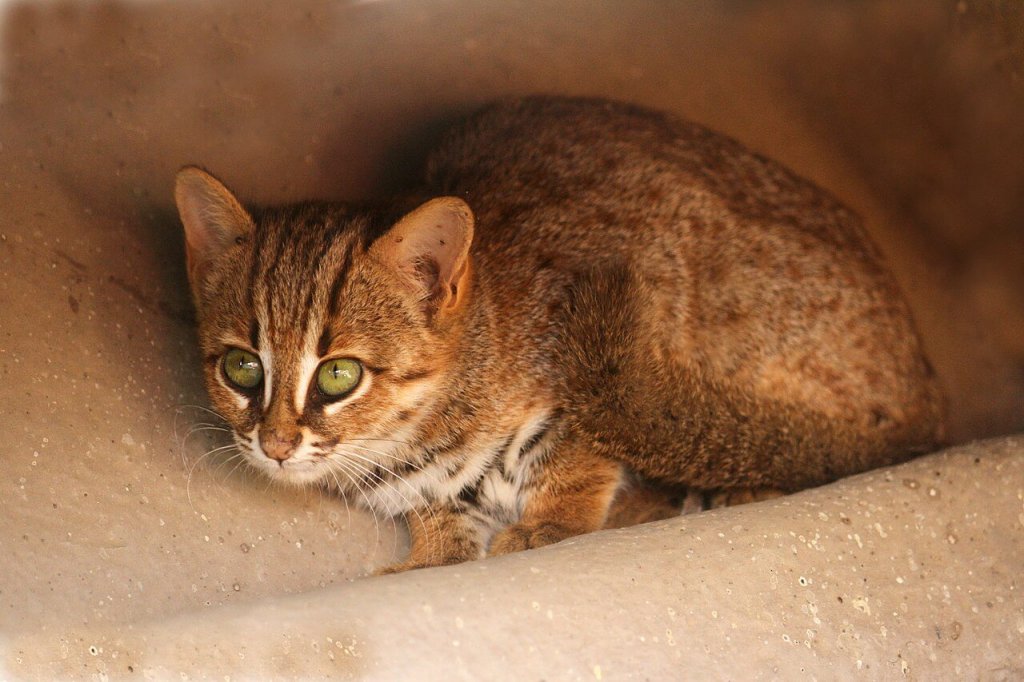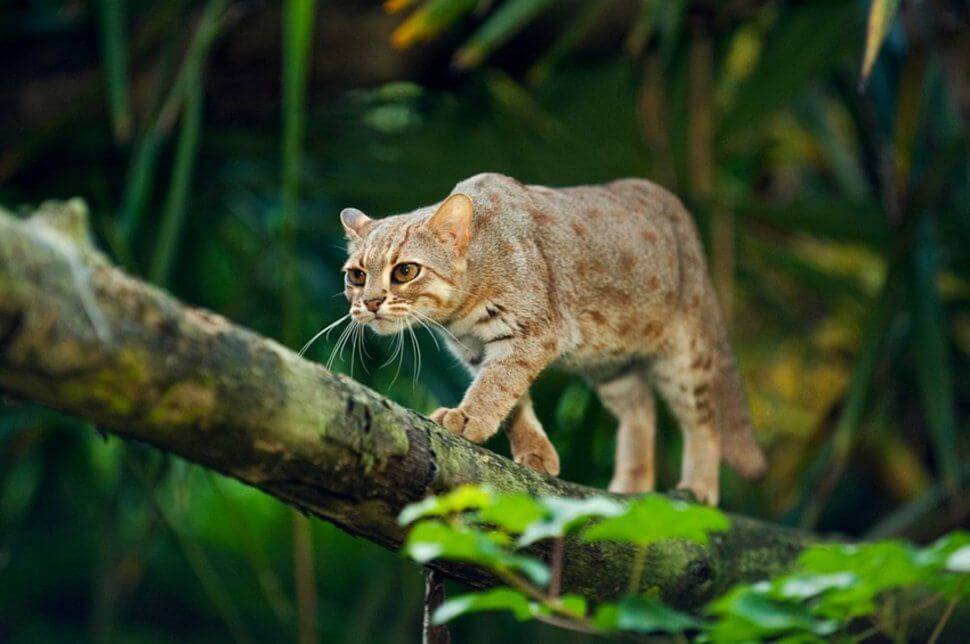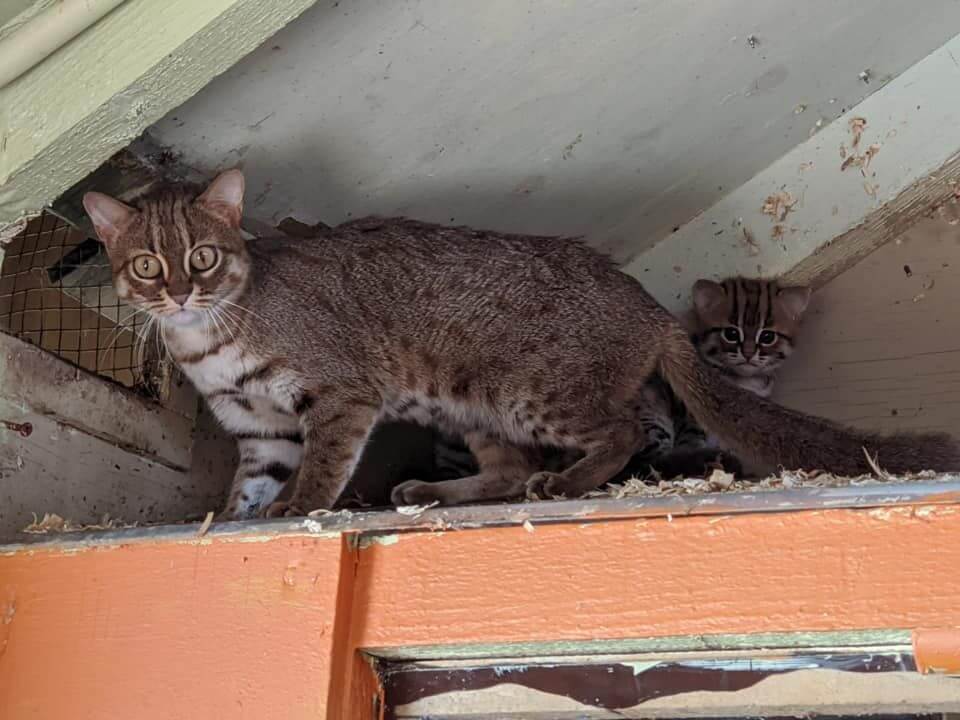The Rusty-Spotted Cat: Habitat and Characteristics

The rusty-spotted cat (Prionailurus rubiginosus) is the smallest wild cat in the world. It’s nocturnal and usually solitary. It feeds especially on birds and rodents, although it also includes some amphibians and insects in its diet.
When hunting, it has a success rate of 60%, one of the highest in the animal kingdom. It hunts mainly on the ground with fast, unpredictable movements. Below, we’ll tell you everything you need to know about this magnificent feline.
Physical characteristics of the rusty-spotted cat
Classified as the smallest of its species, this cat in adulthood reaches a height of just 20 centimeters (8 inches), a length of 35 to 48 centimeters (14 to 19 inches) and a maximum weight of 2 kilograms (4.4 pounds). It’s covered by a coat of short grayish hair over most of its body, adorned with copper-colored spots on its back and a white fur belly with some dark spots.
Its head is triangular with 6 dark stripes on each side. It has pointed ears and large eyes that can be blue, green, or amber. This feline has a visual capacity six times greater than that of a human being, which allows it to identify its prey from high up in the trees.
During the day it prefers to hide in dense vegetation and rocky areas, and it then comes out to hunt at night when it feels safer. It feeds especially on birds and rodents, although it also includes some amphibians and insects in its diet. It usually marks its territories with urine.

Rusty-spotted cat habitat
The rusty-spotted cat is endemic to India, Sri Lanka, and Nepal, and it’s only found in certain parts of these Asian countries. It has been found mainly in areas above 2100 meters (1.3 miles) above sea level. It usually inhabits humid and dry deciduous forests.
Likewise, it has a preference for thickets and rocky areas, where it creates its burrows in caves during the breeding season. Different investigations have estimated that its distribution is 3 to 7 individuals per 100 km2 (38 square miles).
Despite having a predilection for these territories, certain human interventions, such as the destruction of forests, the expansion of agriculture, and the exploitation of natural resources have pushed the rusty cat to inhabit other areas such as agricultural fields or even abandoned buildings.
However, it’s believed that these places inhabited by humans attract a certain number of rodents, which is one of this feline’s main prey. This theory seems to show that the rusty-spotted cat is adapting to new spaces in search of food.
Reproduction
This feline reaches sexual maturity at one and a half years of age, at which time it has copper-colored spots on its body. Mating is fast in order to avoid any type of threat. Gestation lasts 65 to 70 days.
Once gestation is complete, the female is isolated to prepare her den in a cave, where she gives birth to one or two young. At birth, the young weigh only 60 to 70 grams (2 to 3 ounces). These animals can live up to twelve years in captivity, although their life expectancy in the wild is unknown.

Threats and conservation
There are currently an estimated 10,000 rusty-spotted cats on the Asian continent. Their population has been depleted in recent years, as human expansionist activities have destroyed a large amount of forest and grassland. Similarly, the use of some pesticides in agricultural crops is a clear threat to this species, as well as poaching for its fur or even for food.
Moreover, in some areas of India, this animal is used as a pet and has even been crossed with domestic cats.
According to this situation, the International Union for Conservation of Nature (IUCN) has included the rusty-spotted cat in its red list of vulnerable and near-threatened species. It’s also legally protected under the Indian Animal Life Protection Act (ACT-1972).
All cited sources were thoroughly reviewed by our team to ensure their quality, reliability, currency, and validity. The bibliography of this article was considered reliable and of academic or scientific accuracy.
- Chatterjee N, Nigam P, Habib B. Population density and habitat use of two sympatric small cats in a central Indian reserve. PLOS ONE. 2020;15(6):e0233569.
- Vasava A, Chottekamada B, Solanki R. Record of rusty-spotted cat from Kuno Wildlife Sanctuary, Madhya Pradesh, India. Cat News. 2012;57:22-3.
- Sharma SK, Dhakad M. The Rusty-spotted Cat Prionailurus rubiginosus (I. Geoffroy Saint-Hillaire, 1831) (Mammalia: Carnivora: Felidae) in Rajasthan, India – a compilation of two decades. Journal of Threatened Taxa. 2020;12(16):17213-21.
- Vyas R, Upadhyay K. Sightings and distribution of rusty-spotted cat in Gujarat State, India. CATnews. 2014;61:26-9.
